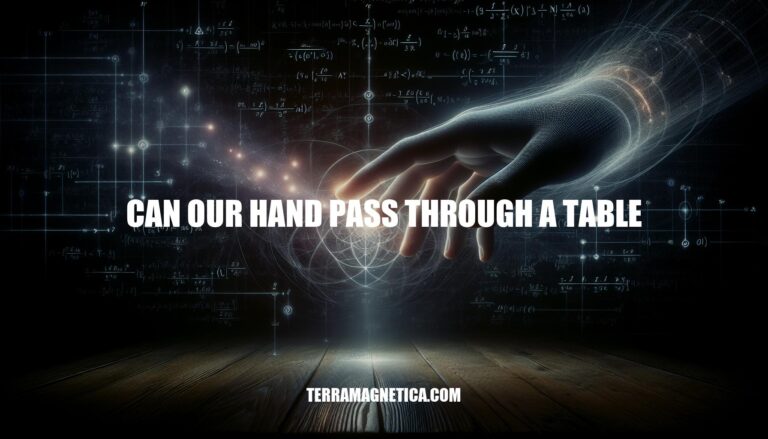


Imagine trying to push your hand through a solid table. Intuitively, we know it’s impossible because our hand and the table are both solid objects. However, in the realm of quantum mechanics, there’s a fascinating concept called quantum tunneling. This phenomenon suggests that, on an incredibly rare occasion, particles can pass through barriers they typically shouldn’t be able to cross.
This question arises because, at the atomic level, matter is mostly empty space, and particles behave in ways that defy our everyday experiences. While quantum tunneling is a real effect, the probability of your hand passing through a table is astronomically low due to the strong electromagnetic forces between the atoms in your hand and the table.
Quantum tunneling is a fascinating phenomenon in quantum mechanics where particles can pass through potential energy barriers that they seemingly shouldn’t be able to cross according to classical physics. This occurs because particles exhibit both wave-like and particle-like properties, known as wave-particle duality.
In classical mechanics, if a particle doesn’t have enough energy to overcome a barrier, it simply can’t pass through. However, in quantum mechanics, the particle’s wave function describes a probability distribution. This wave function can extend through and beyond the barrier, giving a non-zero probability that the particle will appear on the other side.
To address the question of whether our hand can pass through a table at a subatomic level: theoretically, yes, but practically, no. The probability of all the particles in your hand simultaneously tunneling through the table is astronomically low. Quantum tunneling is significant for individual particles like electrons, but for macroscopic objects composed of an enormous number of particles, the likelihood is so small that it’s effectively impossible.
So, while quantum tunneling allows particles to pass through barriers, don’t expect to phase your hand through a table anytime soon!
Electromagnetic forces are responsible for preventing macroscopic objects, like your hand and a table, from passing through each other. This is due to the repulsive forces between the electrons in the atoms of your hand and those in the table. When you try to push your hand through the table, the electrons in the outer shells of the atoms in your hand repel the electrons in the outer shells of the atoms in the table. This repulsion is incredibly strong at very short distances, creating a barrier that feels solid to us.
So, when you try to push your hand through a table, the electromagnetic forces between the atoms in your hand and the table prevent them from occupying the same space, making it practically impossible for your hand to pass through the table.
The Pauli exclusion principle, formulated by Wolfgang Pauli in 1925, states that no two fermions (particles with half-integer spin, like electrons) can occupy the same quantum state simultaneously. This means that in an atom, no two electrons can have the same set of quantum numbers, which define their energy levels and spatial distribution.
This principle is crucial for the structure and stability of matter. It ensures that electrons fill up different energy levels in atoms, creating a structured electron cloud around the nucleus. This structured arrangement prevents electrons from collapsing into the same state, thus maintaining the atom’s volume and preventing it from collapsing.
When you try to push your hand through a table, the electrons in the atoms of your hand and the table repel each other due to the Pauli exclusion principle and electromagnetic forces. This repulsion is incredibly strong, making it impossible for the atoms in your hand to pass through the atoms in the table. Therefore, your hand cannot pass through the table, reinforcing the solidity of matter.
Here are some common misconceptions about quantum mechanics and macroscopic objects, particularly addressing the myth that our hand can pass through a table:
Quantum Tunneling Misunderstanding: Quantum tunneling is a phenomenon where particles pass through barriers they classically shouldn’t be able to. However, this applies to subatomic particles like electrons, not macroscopic objects like hands. The probability of a macroscopic object like a hand tunneling through a table is astronomically low, effectively zero.
Electromagnetic Repulsion: The electrons in the atoms of your hand and the table repel each other due to electromagnetic forces. This repulsion is what prevents your hand from passing through the table. It’s not just about empty space between atoms; the forces at play are incredibly strong.
Pauli Exclusion Principle: This principle states that no two electrons can occupy the same quantum state simultaneously. This principle contributes to the solidity of matter, ensuring that the atoms in your hand and the table cannot overlap.
Macroscopic Coherence: Quantum effects like superposition and entanglement are significant at the microscopic level but do not scale up to macroscopic objects. The coherence required for such effects to be noticeable in large objects is lost due to interactions with the environment.
In essence, while quantum mechanics governs the behavior of particles at the microscopic level, its effects do not translate to macroscopic objects in a way that would allow your hand to pass through a table.
The concept of quantum tunneling suggests that particles can pass through barriers they shouldn’t be able to cross, but this phenomenon is significant for individual particles like electrons, not macroscopic objects like hands.
The probability of all the particles in your hand simultaneously tunneling through a table is astronomically low due to electromagnetic forces between atoms and the Pauli exclusion principle preventing overlap. These principles ensure that the solidity of matter remains intact, making it practically impossible for your hand to pass through a table.